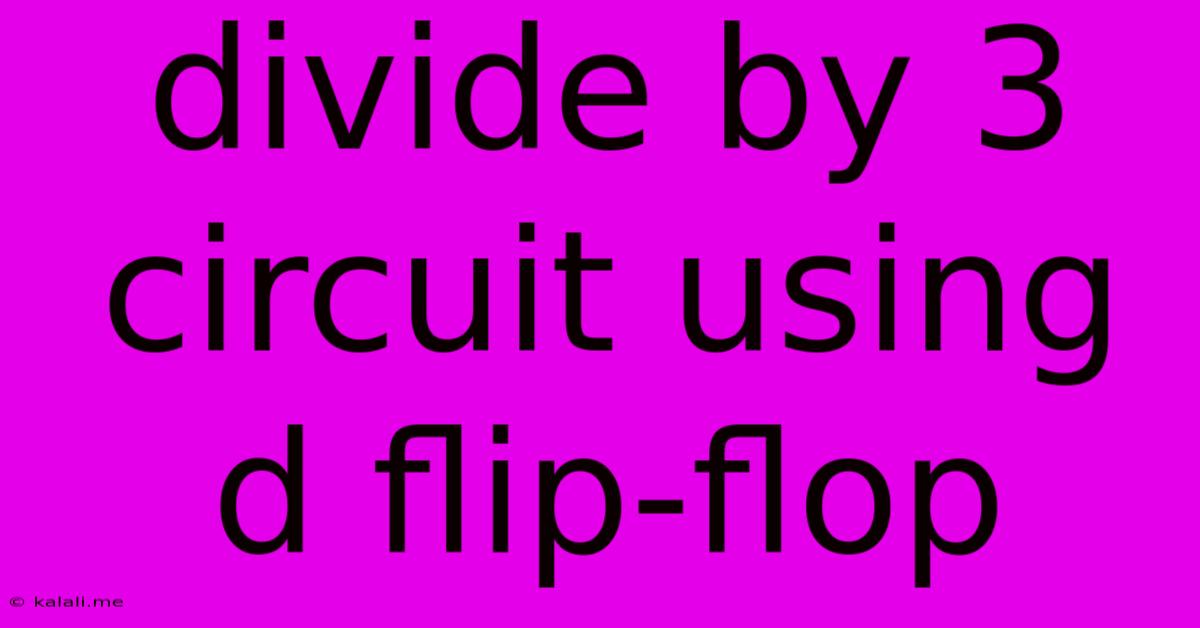Divide By 3 Circuit Using D Flip-flop
Kalali
Jun 06, 2025 · 3 min read

Table of Contents
Divide-by-3 Counter Circuit using D Flip-Flops
This article details the design and functionality of a divide-by-3 counter using D flip-flops. A divide-by-3 counter is a fundamental digital circuit that divides an input clock frequency by three, producing an output clock with one-third the frequency. This is crucial in various applications requiring frequency division, such as clock synchronization, data rate adjustment, and signal processing. Understanding its construction offers a valuable insight into digital logic design.
Understanding the Fundamentals:
Before diving into the circuit design, let's establish a basic understanding of the components involved:
-
D Flip-Flop: A D flip-flop is a fundamental memory element in digital circuits. It stores a single bit of information. The input value (D) is transferred to the output (Q) on the rising (or falling) edge of a clock signal. The output retains its value until the next clock edge.
-
Divide-by-N Counter: A counter that divides the input frequency by 'N' produces one output pulse for every 'N' input pulses. For example, a divide-by-2 counter outputs one pulse for every two input pulses.
Designing the Divide-by-3 Counter:
We can implement a divide-by-3 counter using two D flip-flops. The design relies on creating a specific state sequence that repeats every three clock cycles. Let's consider the following state diagram:
- State 0 (Q1Q0 = 00): Represents the initial state.
- State 1 (Q1Q0 = 01): The counter transitions to this state after one clock pulse.
- State 2 (Q1Q0 = 10): The counter transitions to this state after two clock pulses.
- State 3 (Q1Q0 = 11): This state is skipped; the counter loops back to state 0 after this state.
The D Flip-Flop Inputs:
To achieve this state sequence, we need to determine the D inputs for each flip-flop based on the current state. We can create a truth table to define the D inputs:
| Current State (Q1Q0) | Next State (Q1Q0) | D1 | D0 |
|---|---|---|---|
| 00 | 01 | 0 | 1 |
| 01 | 10 | 1 | 0 |
| 10 | 00 | 0 | 0 |
From this truth table, we can derive the Boolean expressions for D1 and D0:
- D1 = Q0
- D0 = Q1' ⊕ Q0 (⊕ represents the XOR operation)
Circuit Implementation:
The circuit can be implemented using two D flip-flops, an XOR gate, and some connecting wires, based on the Boolean expressions derived above. The output of the counter can be taken from either Q1 or Q0, depending on the desired output waveform. A simple output would be a pulse every three clock cycles. A more sophisticated output might involve using additional logic to generate a different signal pattern.
Advantages and Applications:
The divide-by-3 counter using D flip-flops offers a simple, cost-effective solution for frequency division by three. Its applications include:
- Clock Generation: Generating lower frequency clock signals from a higher frequency source.
- Data Rate Conversion: Adjusting the data rate in communication systems.
- Signal Processing: Used in various signal processing applications requiring frequency division.
Further Considerations:
- Asynchronous vs Synchronous: This design is a synchronous counter, as all flip-flops are clocked simultaneously.
- Variations: Alternative designs using other flip-flop types or combinatorial logic are possible.
- Testing and Verification: Simulation tools are essential for verifying the correct functionality of the circuit before physical implementation.
This detailed explanation provides a comprehensive understanding of building a divide-by-3 counter using D flip-flops. Remember that careful design and verification are crucial in digital circuit implementation.
Latest Posts
Latest Posts
-
Can I Put Water In My Coolant
Jun 07, 2025
-
How To Change Light Bulb Ceiling Fan
Jun 07, 2025
-
3 Places In Acts Where Conflict Occurred
Jun 07, 2025
-
1 2 Or 3 4 Water Supply Line
Jun 07, 2025
-
How Long Is A Rotation In Sstar Wars
Jun 07, 2025
Related Post
Thank you for visiting our website which covers about Divide By 3 Circuit Using D Flip-flop . We hope the information provided has been useful to you. Feel free to contact us if you have any questions or need further assistance. See you next time and don't miss to bookmark.